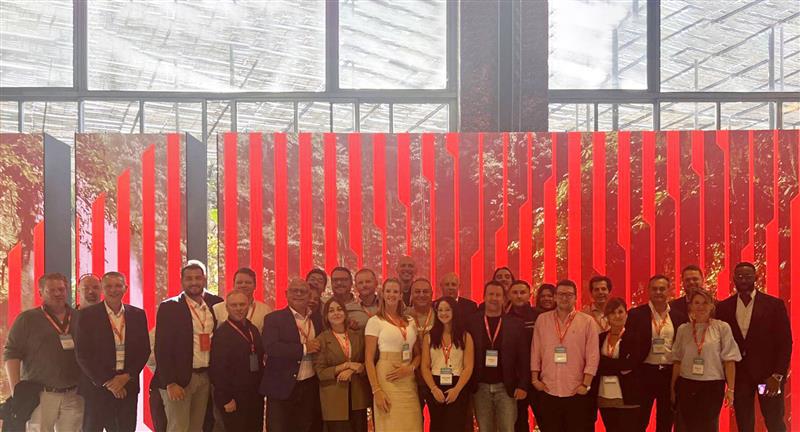
1. Empower people and build trust
Empowering employees benefits the individual and employer, and the key to empowerment in the workplace is personal development and in-career training. Engaged and motivated employees typically enjoy more positive breakthroughs, outshine the competition, innovate more readily and provide excellent customer service. It’s good for the individual, good for business, and good for society, in the words of Michelle Obama, “Empower yourselves with a good education, then get out there and use that education to build a country worthy of your boundless promise.”
2. Drive competitive advantage
When it comes to creating a competitive advantage, at Westcon-Comstor we firmly believe that people remain the greatest asset and biggest competitive advantages for any business. Even though technology is driving digital transformation and market disruption, ensuring the workforce has the necessary skills, capabilities and confidence to drive transformation and navigate today’s rapidly changing marketplace is critical for every business. Nobody would suggest buying a car without learning how to drive first. Technology is no different.
3. Drive innovation
Creating a culture of learning within the workplace drives innovation. A learning culture doesn’t just mean formal training; it comes from the business embracing failure and creating a safe environment where people can learn from their mistakes so they can grow over time. Think of a child learning to walk: they learn and become more resilient by refining their approach based on each failed attempt. In leading organisations and industry disruptors like Tesla, Apple and Microsoft, the rate of failure is high and actively embraced, with Elon Musk saying: “If things are not failing, you are not innovating enough.”
4. Increase performance
According to IDC, the financial impact of the IT skills gap will grow to $775 billion worldwide by 2022 because of the delayed release of products, missed revenue or increased costs. The European Commission believes there are over 750,000 unfilled jobs in the European IT sector alone.
With regard to technology performance, the issue is still as great as it has ever been. A key measure is IT project failure, which is still reported as being extremely high. The Standish Group Chaos Report found that only 29% of IT project implementations are successful; 19% are considered utter failures, with McKinsey arguing that 17% of IT projects can go so bad that they can threaten the very existence of the company.
One of the most effective way of driving performance is to ensure your organisation has the right skills and capability. To my earlier point, you would never buy a Rolls Royce and not invest in learning how to drive. Everyday, organisations are making significant investments in technology to drive their organisational strategy – where they are failing is understanding the skills and competency requirements to recognise the benefit of this technology. This must change.
One of the most effective way of bridging the skills gap is for employers to offer reskilling and upskilling programmes. These help existing employees train in the skills where the organisation is lacking. This type of knowledge transfer and skills building helps both your business and the individual.
5. Attract and retain talent
The workplace demographic is changing. The latest generation entering the workforce want a different kind of relationship with their employers. It is not just a job any more. The more career development they have, the more they buy into your business. And if they see that they can have a fulfilling career from the outset, more of them will stay. At the opposite end of the spectrum, it’s important to also have a strategy for an ageing workforce. Embedding a learning culture in your business will maximise the performance of your existing talent pool and attract new talent.
According to data from the European Labour Force Survey, over 55’s now represent 16% of the total workforce in the European Union and in countries such as Germany, Finland and Sweden the number of mature works is closer to one in five. As a comparison, for every 10 Gen Z staff, there are twelve people aged 65 or older in the EU. Diversity in the workplace can increase ROI, lead to more innovative ideas, and foster a more productive work environment. In fact, companies that place emphasis on diversity are 35% more likely to have financial returns above the industry median.
A robust learning and development structure is critical in attracting the best emerging talent such as university graduates or apprenticeships. According to the UK’s National Apprenticeship Service, 86% of employers said apprenticeships developed skills relevant to their organisation and 78% reported improved productivity.
The average expectancy of an employee remaining in a role is also changing. The 2019 US Bureau of labour statistics survey highlights the average number of jobs in a lifetime is twelve. However, it is important to recognise the difference between ages and the correlation with time in a role, in the US, the average tenure of workers aged 55 to 64 was 10.1 years, more than three times the 2.8 years of workers aged 25 to 34, according to the most recent US statistics.
However, some experts have highlighted that roles in technology, advertising and PR change jobs every few years, or even months, as job hopping is considered necessary to keep up with changes in the market.
6. Deliver organisational strategy
In 2016, it was estimated that 67% of well-formulated organisational strategies failed. Only 10% of organisations surveyed achieve at least two-thirds of their strategy objectives, with 36% achieving between 50-67%, and 54% achieving less than 50%.
Organisations often fail to take the time to understand the requirement for learning in their organisation. At Weston-Comstor, we recommend that organisations take the time to conduct clear personal development planning and think about the skills and competencies their organisation will require over time to deliver their organisational strategy.
We recommend starting with clear mapping of skills and competence against a job role, using various competencies frameworks such as the Skills Framework for Information Age (SFIA) and the European e-Competency Framework (e-CF); these IT frameworks are designed to highlight best practice skills and competency levels against a job role.
Over time, this gives organisations the ability to benchmark their current capability against these evolving frameworks and then make clear development plans for the existing and any new talent which is introduced to the organisation. It is my belief that this is what will ensure that the organisation possesses the right skills and competency to deliver the organisational strategy.
A popular question I often ask organisations, ‘Do you have the skills and capability to disrupt yourself?’
7. Benefit society
Nelson Mandela said: “Education is the most powerful weapon which you can use to change the world.” Education provides everyone with a sense of empowerment; the idea that they have the choice to change their own life and choose their path. When a workforce is skilled, reskilled or upskilled, the wider community benefits. Productivity increases, average income increases, and unemployment decreases. This leads to economic growth and social stability. It starts with learning.
Download our Trends ebook for more insights
Find out more about working at Westcon-Comstor
Find out more about the Westcon Academy and our Education Services



